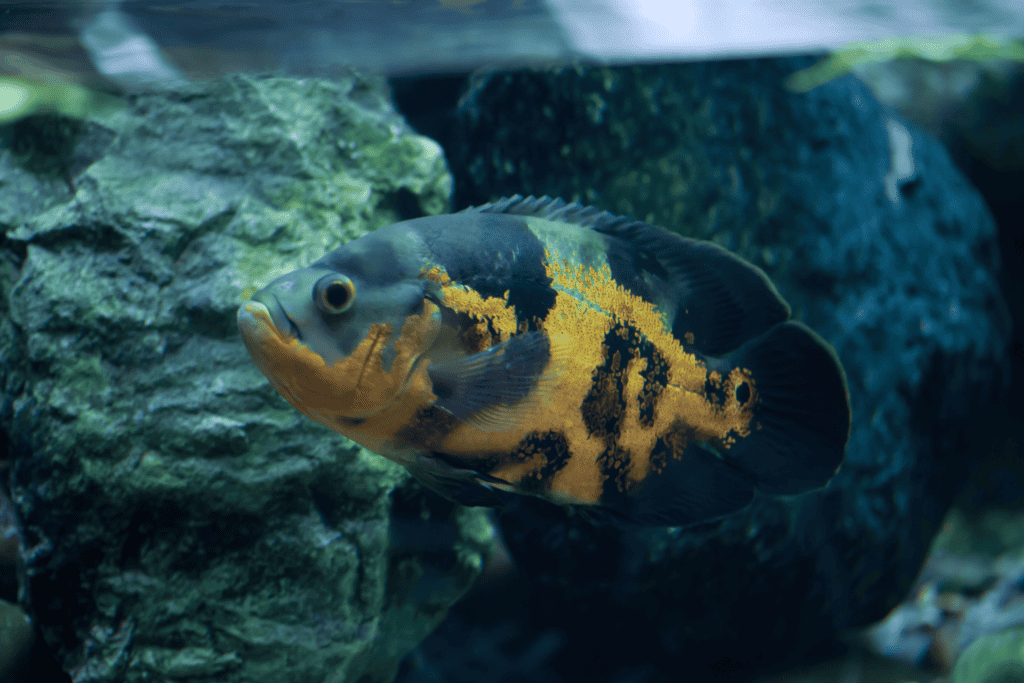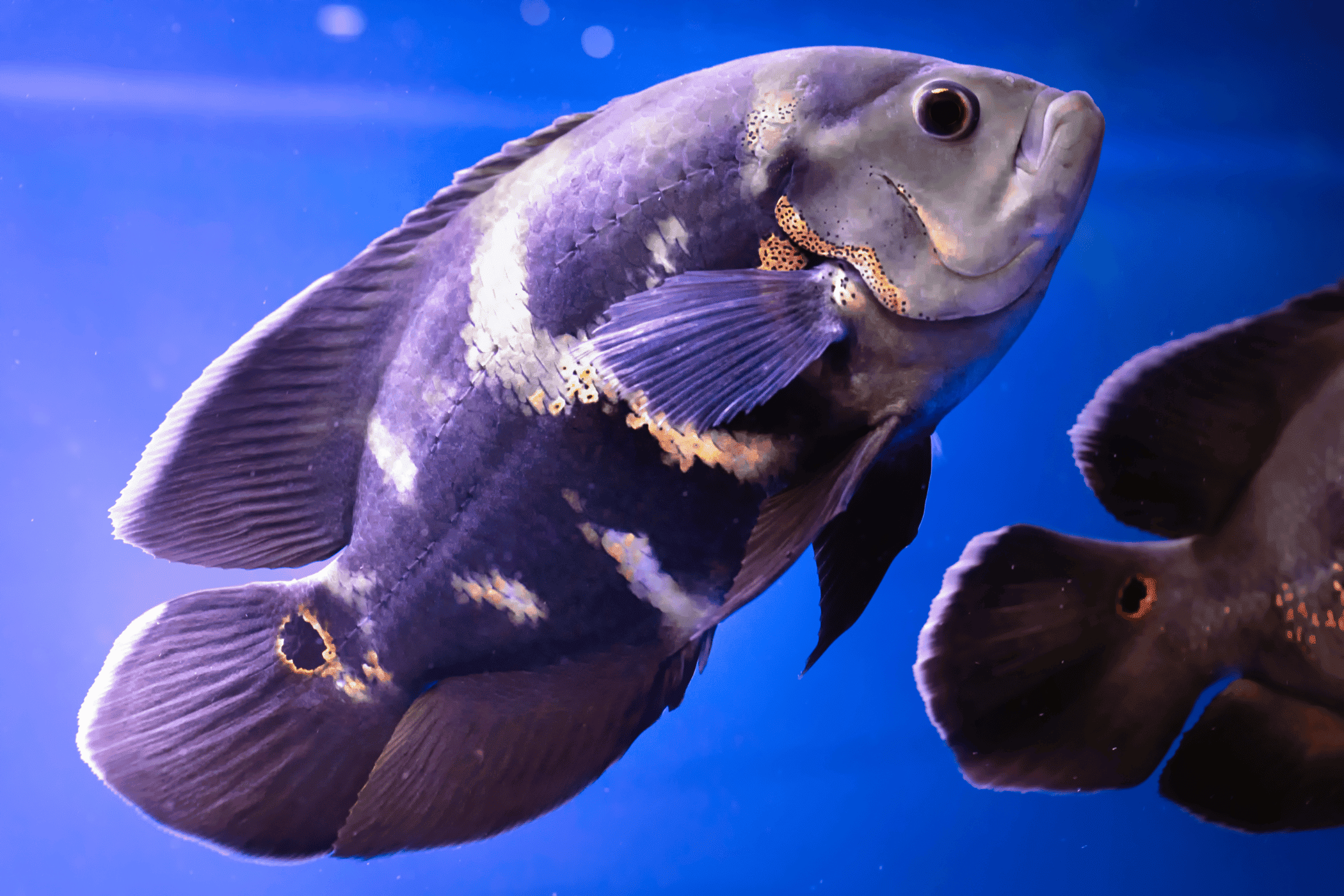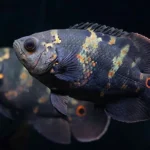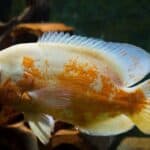Oscar Fish, particularly the blue variant, are known for their vibrant colors and dynamic personalities, making them favorites among freshwater aquarium enthusiasts. Originating from the waterways of South America, Oscars are a species of cichlid and have been captivating hobbyists for years with their intelligence and responsiveness, which can be almost pet-like. They have a range of colors, but the blue Oscar is particularly sought after for its unique hues and patterns.
Blue Oscar Fish require specific care to maintain their health and color vibrancy in an aquarium setting. Tank conditions need to resemble their natural habitat to some degree, which means providing ample space, proper filtration, and stable water parameters. They can grow quite large—up to 12 inches in length—and therefore need a large tank to accommodate their size and territorial behavior. In terms of social dynamics, they generally do best either alone or with other Oscars, as they can be aggressive towards different species.
Key Takeaways
- Oscars offer a special interaction experience mimicking pet-like behavior.
- Proper aquarium care is critical for maintaining the health and vivid color of Blue Oscars.
- Understanding their aggressive nature and potential size is important for harmonious tank management.
Origins and Natural Habitat

In discussing the origins and natural habitat of the blue oscar fish, we focus on their roots in the vast ecosystems of the Amazon and the variations seen across different regions.
Amazonian Roots
Astronotus ocellatus, more commonly known as the oscar fish, includes the spectacular blue oscar fish among its color variants. Hailing from South America, these fish are indigenous to the Amazon River basin. This sprawling ecosystem stretches across countries like Brazil, Peru, and French Guiana. The natural habitat of oscars is typically warm, slow-moving, and often turbid water. They are found in areas with abundant vegetation or submerged wood, which provides essential cover and hunting grounds.
Regional Variance
Specifically within the Amazon basin, oscars exhibit regional variances that may affect their coloration and behavior. While the blue oscar fish is not naturally occurring and is a result of selective breeding, it retains the robust characteristics of its wild counterparts. This adaptive quality means that even within various sections of their natural habitat—spanning murky backwaters to the more oxygen-rich parts of the Amazon tributaries—their resilience remains a hallmark of their survival. Across Brazil, Peru, and beyond, these fish have demonstrated a remarkable capacity to thrive in differing freshwater environments within the Amazonian expanse.
Physical Characteristics and Varieties
Oscar Fish, known scientifically as Astronotus ocellatus, are a popular species in the aquarium hobby due to their distinct physical traits and varied color patterns. We will be discussing the notable features that make Blue Oscar Fish unique, their wide range of hues, and specifics pertaining to the Blue Oscar variety.
Identifying Features
Oscar Fish are characterized by their robust body, large size, and oval shape. They typically grow to about 12 to 14 inches in length. The species has a set of paired pectoral and pelvic fins, as well as prominent dorsal and anal fins that are almost mirror images of each other.
- Body Shape: Oval and laterally compressed
- Size: Up to 14 inches (35.5 cm)
- Fins: Large dorsal and anal fins
Color Variations
Oscar Fish exhibit a variety of colors and patterns. The most common base colors include black, red, and green. However, selective breeding has introduced a wider palette, including blue, albino, and yellow hues.
- Common Base Colors:
- Black
- Red
- Green
- Bred Variations:
- Blue
- Albino
- Yellow
These fish often feature contrasting patterns, such as spots or stripes, adding to their vibrant appearance.
Blue Oscar Specifics
The Blue Oscar, alternatively known as the Marble Cichlid or Velvet Cichlid, is a selectively bred variety that boasts shades of blue on its scales. While the intensity of the blue coloration can vary among individuals, it typically presents against a darker background that may contain hints of other colors such as black or white.
- Distinctive Pattern: Marble-like blue patterns
- Scales: Blue shades ranging from soft to vivid
The Blue Oscar Fish have similar physical features to other Oscars, including their body shape and delicate yet expansive fins. Our focus on the Blue Oscar variety sheds light on their unique aesthetic, making them a sought-after variety for aquarists.
Aquarium Care

Proper aquarium care is essential for the health and wellbeing of Blue Oscar Fish. We will cover the vital components ranging from tank requirements to diet and nutrition for these sizeable freshwater fish.
Tank Requirements
- Minimum Tank Size: For one Oscar, we recommend a 75-gallon aquarium or larger. For multiple Oscars, a 125-gallon tank or more is appropriate.
- Substrate: A soft, sandy substrate is best to prevent injury when Oscar Fish dig and forage.
- Decoration: Include rocks, driftwood, and hiding spaces but ensure ample open space for swimming.
Water Parameters
- Temperature: Maintain 74-81°F (23-27°C) for optimal health.
- pH Levels: The ideal pH range is 6.0-8.0, with 7.0 being neutral.
- Ammonia, Nitrite, Nitrate: Monitor levels regularly — ammonia and nitrite should be 0 ppm, and nitrate should be <20 ppm.
- Filtration: A powerful filter is necessary to handle the bioload of Oscars. Aim for a turnover rate of 4-5 times the tank volume per hour.
- Water Flow: Provide moderate water flow to mimic natural habitats and facilitate proper waste dispersal.
| Parameter | Ideal Range |
|---|---|
| Temperature | 74-81°F (23-27°C) |
| pH | 6.0-8.0 |
| Ammonia | 0 ppm |
| Nitrite | 0 ppm |
| Nitrate | <20 ppm |
Diet and Nutrition
- Food Types: Offer a varied diet consisting of high-quality pellets, live foods (as treats), and suitable vegetables.
- Feeding Routine: Feed adults once or twice a day, and avoid overfeeding to maintain water quality and prevent obesity.
Health and Disease Prevention
- Water Quality: Consistent water quality checks and regular water changes are crucial in preventing disease.
- Disease Watch: Keep an eye out for common Oscar ailments such as ich — characterized by white spots on the skin and gills.
- Large Tank Concerns: Spacious tanks help prevent territorial stress and associated health issues.
Remember, prevention is better than cure, so we always strive to maintain the highest standards of care for our Blue Oscar Fish’s environment.

Behavior and Social Dynamics
When considering blue Oscar fish, it’s essential to understand their complex behavior and how they interact with others within their environment. We’ll explore the specifics of their temperament and how they fare with various tank mates.
Temperament and Interaction
Blue Oscars tend to exhibit a bold and curious nature. They are intelligent fish capable of recognizing their owners and can exhibit a range of behaviors from playful to aggressive, particularly during feeding times or when establishing territory. Their behavior often includes:
- Territorial actions: Establishing and defending a chosen area within the tank.
- Display of dominance: Might flare their gills or rapidly shake their bodies to assert dominance.
It’s pivotal to consider the size of their habitat, as cramped conditions can exacerbate aggressive tendencies.
Compatibility with Tank Mates
Blue Oscars are a species of the cichlid family (Cichlidae) and their interaction with other tank mates must be approached with caution due to their potential aggression. Appropriate tank mates often include:
- Silver Dollars: Generally peaceful and can match the size of Oscars as they grow.
- Convict Cichlids: While smaller, they are robust and can typically handle themselves with Oscars.
To minimize conflict, we need to ensure:
- Spacious Tanks: Ample space for all inhabitants to prevent territorial disputes.
- Visual Barriers: Providing hiding spots and decorations to break the line of sight between aggressive individuals.
When adding other cichlids or similar-sized fish to the aquarium, careful observation is crucial to ensure the safety and well-being of all species involved.
Frequently Asked Questions
Oscar Fish are a popular choice for aquarium enthusiasts, and we often receive numerous inquiries about their care, distinguishing features, price, and quality. We’ve compiled these FAQs to help guide you through the common concerns and interests regarding different Oscar Fish varieties.
What are the distinctive features of Electric Blue Oscar Fish?
Electric Blue Oscar Fish are known for their vibrant cobalt blue coloration which can vary from pale to dark blue. Their unique color and active personality make them a standout in any aquarium.
How to care for a Black Oscar Fish?
Black Oscar Fish require a large tank, optimum water conditions with a temperature between 74-81°F (23-27°C), and a pH of 6.5-7.2. They are omnivores, so a varied diet of pellets, live food, and vegetables is essential for their health.
What price range can be expected for different types of Oscar Fish?
The price of Oscar Fish varies based on size, coloration, and quality, ranging from $10 to $100. Electric Blue Oscars tend to be more expensive due to their striking appearance, while common varieties like the Tiger Oscar are usually less costly.
Can you differentiate between the various Oscar Fish colors?
Oscar Fish come in several colors including red, orange, blue, green, and black. Each color variant typically displays unique patterns, with some featuring a mix of hues like the Red Tiger Oscar, which has red and orange markings against a darker base.
How would you identify a high-quality Oscar Fish?
A high-quality Oscar Fish should have bright, clear eyes, vibrant coloration without dull patches, and exhibit no signs of white spots or ragged fins. Their activity level should be high as Oscar Fish are known for their liveliness.
What are the care requirements for a Green Oscar Fish?
Caring for Green Oscar Fish involves maintaining a large tank with plenty of hiding places, a diet that includes both plant-based and protein-rich foods, and keeping the water clean to prevent disease. Regular water changes and tank monitoring are essential for their well-being.
What is a blueberry Oscar fish?
The “Blueberry Oscar Fish” is a term sometimes used in the aquarium trade, but it’s important to clarify that this is not a scientifically recognized or natural variety of Oscar fish. Oscars, known scientifically as Astronotus ocellatus, are a large species of cichlid native to South America, particularly the Amazon River basin. In their natural habitat, Oscars typically display colors like black, orange, and white.
The “Blueberry Oscar” is likely a product of selective breeding or, more concerningly, artificial coloring. In the aquarium trade, there are practices where fish are dyed through injections, feeding them dyed food, or immersing them in colored solutions to enhance or change their color. This practice is considered unethical and harmful to the fish’s health, as it can cause stress, immune suppression, and even shorten their lifespan.
The term “Blueberry Oscar Fish” often refers to an Albino Oscar that has been injected with blue dye. This practice is a part of the aquarium trade where certain fish are artificially colored to make them more appealing to buyers. Unfortunately, this process is not only unethical but can also be harmful to the fish.
In the case of the Blueberry Oscar, the base fish is typically an Albino Oscar, which naturally has a lack of pigmentation, making it appear white or pale in color. The blue dye is then injected into the fish, or the fish are soaked in a solution containing the dye, to give them a bright blue appearance. This artificial coloring process can lead to various health problems for the fish, including increased stress, a weakened immune system, and potentially shortened lifespan.
It’s important for aquarium enthusiasts to be aware of the origins of unusually colored fish and to make ethical choices when selecting fish for their aquariums. Supporting practices that harm fish welfare can encourage the continuation of such unethical treatments in the industry. Therefore, it’s advisable to seek naturally colored varieties of fish and to buy from reputable breeders or sellers who prioritize the health and well-being of their fish.






